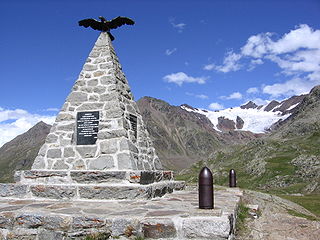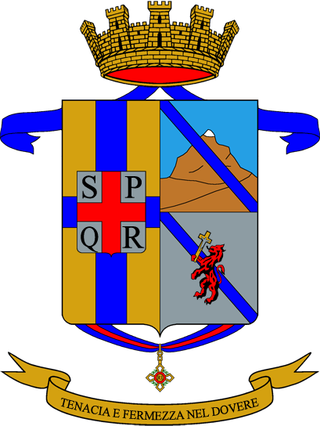| |||||
| Decades: | |||||
|---|---|---|---|---|---|
| See also: | |||||
Events from the year 1918 in Italy .
| |||||
| Decades: | |||||
|---|---|---|---|---|---|
| See also: | |||||
Events from the year 1918 in Italy .
In the autumn of 1917 at the Battle of Caporetto, the Germans and Austrians had defeated the Italians who fell back to the Piave. The Royal Italian Army lost over 300,000 men. Italy reorganizes the army under the new commander General Armando Diaz and receives reinforcements of the Allied powers.


The Battle of Caporetto took place on the Italian front of World War I.

The Battle of San Matteo took place in the late summer of 1918 on the Punta San Matteo during World War I. It was regarded as the highest battle in history until it was surpassed in 1999 by the Kargil Conflict at 5,600 m.

The Second Battle of the Piave River, fought between 15 and 23 June 1918, was a decisive victory for the Italian Army against the Austro-Hungarian Empire during World War I, as Italy was part of the Allied Forces, while Austria-Hungary was part of the Central Powers. Though the battle proved to be a decisive blow to the Austro-Hungarian Empire and by extension the Central Powers, its full significance was not initially appreciated in Italy. Yet Erich Ludendorff, on hearing the news, is reported to have said he 'had the sensation of defeat for the first time'. It would later become clear that the battle was in fact the beginning of the end of the Austro-Hungarian Empire.

The Italian front was one of the main theatres of war of World War I. It involved a series of military engagements along the border between the Kingdom of Italy and Austria-Hungary from 1915 to 1918. Following secret promises made by the Allies in the 1915 Treaty of London, the Kingdom of Italy entered the war on the Allied side, aiming to annex the Austrian Littoral, northern Dalmatia and the territories of present-day Trentino and South Tyrol. The front soon bogged down into trench warfare, similar to that on the Western Front, but at high altitudes and with extremely cold winters. Fighting along the front displaced much of the local population, and several thousand civilians died from malnutrition and illness in Italian and Austro-Hungarian refugee camps.
The 10th Army was a field army of the Royal Italian Army, which fought in World War I and in Italian North Africa during World War II.

The Battle of Vittorio Veneto was fought from 24 October to 3 November 1918 near Vittorio Veneto on the Italian Front during World War I. After having thoroughly defeated Austro-Hungarian troops during the defensive Battle of the Piave River, the Italian army launched a great counter-offensive: the Italian victory marked the end of the war on the Italian Front, secured the dissolution of the Austro-Hungarian Empire and contributed to the end of the First World War just one week later. The battle led to the capture of over 5,000 artillery pieces and over 350,000 Austro-Hungarian troops, including 120,000 Germans, 83,000 Czechs and Slovaks, 60,000 South Slavs, 40,000 Poles, several tens of thousands of Romanians and Ukrainians, and 7,000 Austro-Hungarian loyalist Italians and Friulians.

San Biagio di Callalta is a comune (municipality) in the province of Treviso, Veneto, north-eastern Italy.

The Armistice of Villa Giusti or Padua Armistice was an armistice convention with Austria-Hungary which de facto ended warfare between Allies and Associated Powers and Austria-Hungary during World War I. Allies and Associated Powers were represented by Italy. The armistice protocol together with a supplementary protocol was signed on 3 November 1918 in the Villa Giusti, outside Padua in the Veneto, Northern Italy, and took effect 24 hours later. This armistice applied only on Austria because Hungary later signed the separate Belgrade armistice.

Although a member of the Triple Alliance, Italy did not join the Central Powers – Germany and Austria-Hungary – when the war started with Austria-Hungary's declaration of war on Serbia on 28 July 1914. In fact, the two Central Powers had taken the offensive while the Triple Alliance was supposed to be a defensive alliance. Moreover the Triple Alliance recognized that both Italy and Austria-Hungary were interested in the Balkans and required both to consult each other before changing the status quo and to provide compensation for whatever advantage in that area: Austria-Hungary did consult Germany but not Italy before issuing the ultimatum to Serbia, and refused any compensation before the end of the war.

Gaetano Giardino was an Italian soldier that rose to the rank of Marshal of Italy and Italian Representative to the Allied War Council during World War I.
In the aftermath of the First World War, the Adriatic question or Adriatic problem concerned the fate of the territories along the eastern coast of the Adriatic Sea that formerly belonged to the Austro-Hungarian Empire. The roots of the dispute lay in the secret Treaty of London, signed during the war, and in growing nationalism, especially Italian irredentism and Yugoslavism, which led ultimately to the creation of Yugoslavia. The question was a major barrier to agreement at the Paris Peace Conference, but was partially resolved by the Treaty of Rapallo between Italy and Yugoslavia on 12 November 1920.

Wenzel Freiherr von Wurm was a Colonel General in the Austro-Hungarian Army.

The 11th Bersaglieri Battalion "Caprera" is an inactive Italian Army Bersaglieri unit. Originally formed in 1910 by the 11th Bersaglieri Regiment as a cyclists battalion, the battalion fought separate from the regiment on the Italian front during World War I. With three Silver Medals of Military Valor the battalion was the most decorated Bersaglieri unit of the war.

The 152nd Infantry Regiment "Sassari" is an active unit of the Italian Army based in Sassari in Sardinia. The regiment is named for the city of Sassari and part of the Italian Army's infantry arm. As of 2023 the regiment is assigned to the Mechanized Brigade "Sassari".

Ludwig Goiginger was an Austro-Hungarian Lieutenant Field Marshal who notably served in World War I.

The 45th Infantry Regiment "Reggio" is an active unit of the Italian Army based in Sassari in Sardinia. The unit is named for the city of Reggio Emilia and part of the Italian Army's infantry arm. On 1 October 2022, the name, flag and traditions of the regiment were assigned to the Command and Tactical Supports Unit "Sassari" of the Mechanized Brigade "Sassari". On the same day the unit was renamed 45th Command and Tactical Supports Unit "Reggio". On 1 July 1859, during the Second Italian War of Independence, a Volunteer Battalion was formed in Modena. By 29 July, three volunteer battalions had been formed and the three battalions were used to form the 3rd Infantry Regiment. In August 1860, the regiment was assigned, together with the 4th Infantry Regiment, to the newly formed Brigade "Reggio" of the Army of the League of Central Italy. On 1 January 1860, the 3rd Infantry Regiment was renumbered 45th Infantry Regiment, and on 25 March 1860, the regiment joined the Royal Sardinian Army.

The 46th Infantry Regiment "Reggio" is an inactive unit of the Italian Army last based in Palermo. The regiment is named for the city of Reggio Emilia and part of the Italian Army's infantry arm. On 8 August 1859, a Volunteer Battalion was formed in Modena, which soon was assigned with two other volunteer battalions to the newly formed 4th Infantry Regiment. The new regiment was assigned, together with the 3rd Infantry Regiment, to the newly formed Brigade "Reggio" of the Army of the League of Central Italy. On 1 January 1860, the 4th Infantry Regiment was renumbered 46th Infantry Regiment, and on 25 March 1860, the regiment joined the Royal Sardinian Army.

The 41st Infantry Regiment "Modena" is an inactive unit of the Italian Army last based in Gradisca d'Isonzo. The regiment is named for the city of Modena and part of the Italian Army's infantry arm. On 7 May 1859, a volunteer unit was formed in Sarzana, which on 16 June was split into two regiments. The two regiment were assigned to the newly formed Brigade "Modena". On 1 January 1860, the two regiments were renumbered 41st Infantry Regiment and 42nd Infantry Regiment, and on 25 March 1860, the regiments joined the Royal Sardinian Army.

The 33rd Infantry Regiment "Livorno" is an inactive unit of the Italian Army last based in Fogliano Redipuglia. The regiment is named for the city of Livorno and part of the Italian Army's infantry arm. The regiment was one of five line infantry regiments formed by the Provisional Government of Tuscany on 5 May 1859 during the Second Italian War of Independence. In 1860, the regiment joined the Royal Sardinian Army. In 1866, the 33rd Infantry Regiment participated in the Third Italian War of Independence. In World War I the regiment fought on the Italian front.

The 23rd Infantry Regiment "Como" is an inactive unit of the Italian Army last based in Como in Lombardy. The regiment is named for the city of Como and part of the Italian Army's infantry arm. The regiment was formed in 1848 by the Royal Sardinian Army during the First Italian War of Independence. After the war the regiment was disbanded. In 1859, the regiment was reformed after the Kingdom of Sardinia annexed Lombardy after the Second Italian War of Independence. In 1866, the regiment fought in the Third Italian War of Independence and in 1911–12 in the Italo-Turkish War. During World War I the regiment fought on the Italian front. During World War II, the regiment was assigned to the 14th Infantry Division "Isonzo", with which it fought in 1941 in the Invasion of Yugoslavia. The division then served on anti-partistan duty in occupied Yugoslavia. After the announcement of the Armistice of Cassibile on 8 September 1943, the division and its regiments were disbanded by invading German forces.
... Ludendorff wrote: In Vittorio Veneto, Austria did not lose a battle, but lose the war and itself, dragging Germany in its fall. Without the destructive battle of Vittorio Veneto, we would have been able, in a military union with the Austro-Hungarian monarchy, to continue the desperate resistance through the whole winter, in order to obtain a less harsh peace, because the Allies were very fatigued.